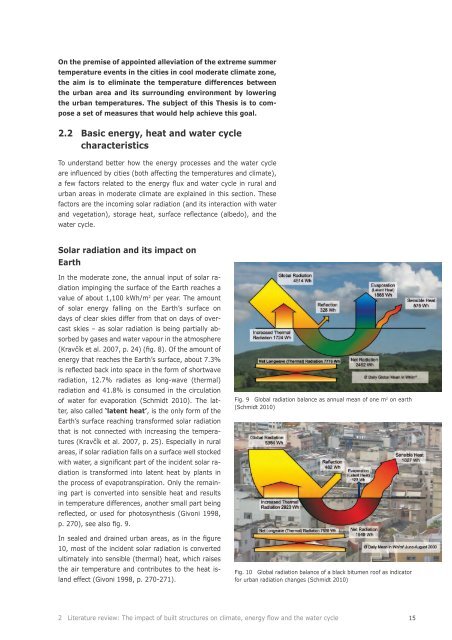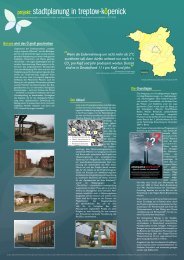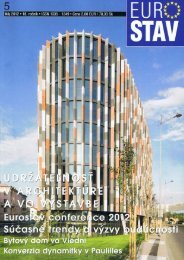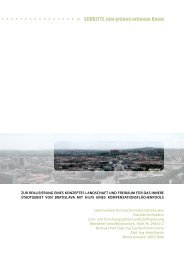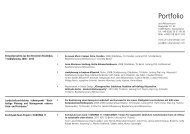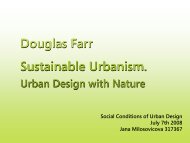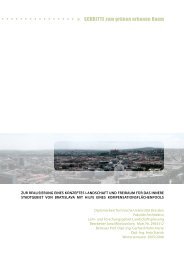On the premise of appointed alleviation of the extreme summertemperature events in the cities in cool moderate climate zone,the aim is to eliminate the temperature differences betweenthe urban area and its surrounding environment by loweringthe urban temperatures. The subject of this <strong>Thesis</strong> is to composea set of measures that would help achieve this goal.2.2 Basic energy, heat and water cyclecharacteristicsTo understand better how the energy processes and the water cycleare influenced by cities (both affecting the temperatures and climate),a few factors related to the energy flux and water cycle in rural andurban areas in moderate climate are explained in this section. Thesefactors are the incoming solar radiation (and its interaction with waterand vegetation), storage heat, surface reflectance (albedo), and thewater cycle.Solar radiation and its impact onEarthIn the moderate zone, the annual input of solar radiationimpinging the surface of the Earth reaches avalue of about 1,100 kWh/m 2 per year. The amountof solar energy falling on the Earth’s surface ondays of clear skies differ from that on days of overcastskies – as solar radiation is being partially absorbedby gases and water vapour in the atmosphere(Kravčík et al. 2007, p. 24) (fig. 8). Of the amount ofenergy that reaches the Earth’s surface, about 7.3%is reflected back into space in the form of shortwaveradiation, 12.7% radiates as long-wave (thermal)radiation and 41.8% is consumed in the circulationof water for evaporation (Schmidt 2010). The latter,also called ‘latent heat’, is the only form of theEarth’s surface reaching transformed solar radiationthat is not connected with increasing the temperatures(Kravčík et al. 2007, p. 25). Especially in ruralareas, if solar radiation falls on a surface well stockedwith water, a significant part of the incident solar radiationis transformed into latent heat by plants inthe process of evapotranspiration. Only the remainingpart is converted into sensible heat and resultsin temperature differences, another small part beingreflected, or used for photosynthesis (Givoni 1998,p. 270), see also fig. 9.In sealed and drained urban areas, as in the figure10, most of the incident solar radiation is convertedultimately into sensible (thermal) heat, which raisesthe air temperature and contributes to the heat islandeffect (Givoni 1998, p. 270-271).Fig. 9 Global radiation balance as annual mean of one m 2 on earth(Schmidt 2010)Fig. 10 Global radiation balance of a black bitumen roof as indicatorfor urban radiation changes (Schmidt 2010)2 Literature review: The impact of built structures on climate, energy flow and the water cycle15
-°CFig. 11 Photographs of thin vegetation inthe visible spectrum (above) and in the infraredspectrum (below). The bare surface ofthe ground is visibly warmer than the surfaceof the leaves cooled by transpiration. Třeboň,Czech Republic, 12 July 2002, 10:00 (Kravčíket al. 2007, p. 27)-°C+°C+kWhAs the water evaporates from a surface, latent heat is removed withthe water vapour effectively cooling it. 11 This process happens throughboth evaporation of water from a surface and transpiration throughplants. As a result of the evapotranspiration process, the air in greenareas is cooler than the air in built-up areas covered by asphalt orconcrete (Givoni 1998, p. 307). The cooling effect of plants caused byevapotranspiration is apparent in the figure 11. The pictures show thatthe leaves of the plants are, thanks to transpiration, visibly cooler thanthe surrounding soil (Kravčík et al. 2007, p. 27).Therefore, water surfaces, soil saturated with water and vegetation allhave a significant cooling effect and air-conditioning capability (Kravčíket al. 2007, p. 15). The imperative message thus is that the design ofsurfaces in the urban environment needs to support evapotranspirationas main priority in urban design.Translated into designer’s language, trees, vines and high dense shrubsnext to walls, pergolas and roof vegetation have impacts on the climateon and around buildings – they protect by their shading and cooling effectfrom overradiation, while certain ventilation is still provided. 12 (Ifdeciduous, the vegetation will not have negative impacts such as reducingof the desired solar gain in winter or increase in walls’ wetness.)Transpiring plants, especially trees, are the perfect natural airconditioningsystem. On the crown of a large tree of about 10 m in diameter,with a surface area of 80 m 2 , there falls each day about 450 kWh ofsolar energy (4-6 kWh/m 2 ). Part of the solar energy is reflected, partis absorbed by the soil and part is converted into heat. If such a treeis well stocked with water, particularly when planted over vegetatedand non-sealed surfaces (Meier et al. 2010), it evapotranspires some400 litres of water each day, consumig about 280 kWh. This amountof energy represents the difference between the shadow of a tree (absorbedand reflected energy is 170 kWh) and the shadow of a parasolwith the same diameter (absorbed and reflected energy is 450 kWh)(fig. 12). In the course of a sunny day, then, such a tree cools with apower equal to 20-30 kW, power comparable to that of more than 10air-conditioning units (Kravčík et al. 2007, p. 27).Additionally, ground cover by plants around a building reduces the reflectedsolar radiation emitted toward the walls, thus lowering the heatgain in the summer.However, unlike in case of vegetated surfaces, where the energy isFig. 12 A tree with 10 m diameter “consumes”solar energy and transforms it intolatent heat in the process of evapotranspiration(left) / Shading devices have the sameshading effect as trees, however emit additional280 kwh of absorbed and reflected solarradiation, which heat up the atmosphere(right)11 Evaporation of a liquid takes place at every temperature. The specific latent heatof water under normal pressure and at a temperature of 25 °C is 2243.7 kJ/kg- which is the amount of solar energy consumed to evaporate each liter of waterwithout increasing the temperature (This same amount of heat is released laterduring condensation of the water vapor in a colder place). If the water howeveris not present on land, a great part of the solar energy is changed into sensibleheat and the temperature of the environment sharply increases (Kravčík et al.2007, p. 25). It is important to add, that with every 10 g of by the plant createdorganic material, not only about 2.1 kWh of thermal energy will be “consumed”,but also about 14g of the commonly discussed CO 2(Kravčík et al. 2007, p. 32)!12 The results of various experimental studies on the positive climatic impacts ofvegetation in urban areas and in close proximity of, or on buildings, conductedby various authors, were summarized by Givoni (1998, p. 309-318).16Climate Sensitive <strong>Urban</strong> <strong>Design</strong> in Moderate Climate Zone: Responding to Future Heat Waves. Case Study Berlin Heidestrasse/Europacity


